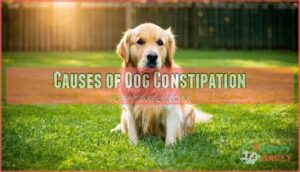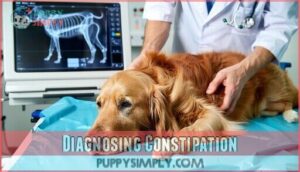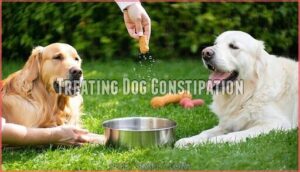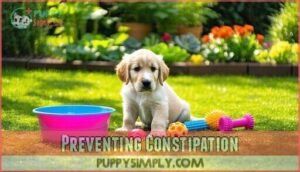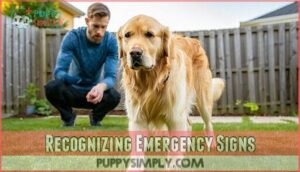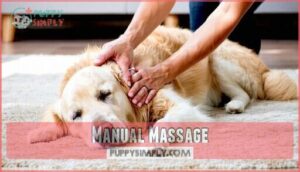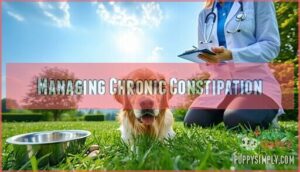This site is supported by our readers. We may earn a commission, at no cost to you, if you purchase through links.

Watch for straining, whining, or small, dry stools. Try increasing their water intake, adding fiber (like canned pumpkin) to meals, or encouraging more activity.
If nothing improves after a day or two, or you notice distress, vomiting, or lethargy, it’s time to call your vet. Chronic constipation can signal bigger issues, so catching it early keeps your pup happy and healthy.
Table Of Contents
- Key Takeaways
- Dog Constipation Defined
- Signs of Constipation
- Causes of Dog Constipation
- Diagnosing Constipation
- Treating Dog Constipation
- Preventing Constipation
- Recognizing Emergency Signs
- Home Remedies for Constipation
- When to See a Vet
- Managing Chronic Constipation
- Frequently Asked Questions (FAQs)
- What to do if your dog keeps squatting but not pooping?
- How do I tell if my dog is constipated or has a blockage?
- Why is my dog constantly trying to poop?
- What can I do if my dog is constipated?
- What are common signs of constipation in dogs?
- Is it normal for a dog to take a long time to poop?
- How can I help my dog poop outside faster?
- Are there any natural remedies for constipation in dogs?
- Can stress or anxiety cause difficulty pooping?
- How does dehydration impact a dogs bowel movements?
- Conclusion
Key Takeaways
- Keep your dog hydrated and add fiber-rich foods like canned pumpkin to their meals to ease constipation.
- Watch for signs like straining, hard stools, or discomfort, and act quickly if symptoms persist or worsen.
- Regular exercise and preventing access to indigestible objects can help maintain healthy bowel movements.
- Contact your vet immediately if your dog shows severe pain, vomiting, or hasn’t pooped in over two days.
Dog Constipation Defined
If your dog’s struggling to poop, you’re likely dealing with constipation, a common yet uncomfortable condition for your furry friend.
Constipation can be tough on your dog, but quick action and care can restore their comfort and happiness.
Understanding what constipation means can help you quickly identify and address your dog’s digestive discomfort, ensuring they get back to their happy, healthy self.
Difficulty Passing Feces
If your dog’s struggling to poop, you might be dealing with difficulty passing feces—a telltale sign of constipation.
Watch for straining symptoms like hard stool, anus redness, and passing mucus.
When your furry friend seems uncomfortable and can’t seem to complete the job, abdominal pain could signal something’s wrong, which may indicate the need for quick observation to prevent more serious issues.
Quick observation can prevent more serious issues.
Infrequent Bowel Movements
When your furry friend isn’t dropping logs like clockwork, infrequent bowel movements could signal trouble.
Here’s what you need to know about your pup’s poop schedule:
- Normal frequency varies by dog’s size and diet
- Sudden changes warrant close attention
- Dehydration can slow things down dramatically
- Aging impacts digestive regularity
Your dog’s bathroom habits speak volumes about their overall health. Watch for patterns that deviate from their usual rhythm.
Causes of Constipation
When your pup struggles to poop, multiple factors could be at play.
Dietary indiscretion, like swallowing unusual objects, often triggers dog constipation.
Stress factors, prostate enlargement, and a sedentary lifestyle can disrupt normal bowel movements.
Dehydration and poor diet compound the problem, making hard stools a frustrating reality for both you and your furry friend, due to dietary indiscretion and sedentary lifestyle.
Signs of Constipation
After understanding what dog constipation means, recognizing its signs becomes critical for pet owners.
When your four-legged friend is straining to poop, something’s wrong.
Watch for red flags like excessive squatting, mucus passage around the anus, and redness or swelling.
Hard, pellet-like stools signal trouble, while bloating and apparent pain during bathroom attempts are warning signs.
If you notice your companion circling repeatedly, whining during attempts to defecate, or showing discomfort when their belly is gently pressed, constipation might be the culprit.
These symptoms suggest your dog’s digestive system needs attention and potential veterinary intervention.
The presence of these signs indicates that your dog is experiencing digestive system issues that require immediate attention.
It is crucial for pet owners to be aware of these warning signs to ensure their dog receives the necessary care.
Causes of Dog Constipation
If your dog’s struggling to poop, you’re not alone in this frustrating situation.
Understanding the key causes of canine constipation can help you quickly identify and address why your furry friend keeps straining without success.
Low Fiber Intake
Ever wondered why your dog’s struggling to go?
Low fiber deficiency can wreak havoc on digestive health, leading to uncomfortable dog constipation.
A fiber-poor diet directly impacts stool consistency, making hard stools a common problem.
Increasing dietary fiber through high-quality dog food or supplementation can help prevent these digestive challenges and maintain your furry friend’s overall nutritional balance.
If a dog hasn’t defecated in 2-3 days, it’s important to seek veterinary care promptly to address potential constipation issues and ensure the dog’s health is not at risk due to low fiber intake.
Swallowing Indigestible Objects
After loading up on fiber, your dog might graduate to an even riskier digestive adventure: swallowing indigestible objects.
Dogs’ curiosity can lead to serious intestinal challenges. Watch out for these common culprits:
- Rocks and sticks
- Socks and clothing
- Paper products
- Food wrappers
- Household items.
Object identification is key.
Labrador and Golden Retrievers are especially prone to foreign object ingestion, which can quickly escalate from minor discomfort to potential surgical intervention. This condition is a serious intestinal challenge.
Intestinal Blockage
Despite seeming like a minor issue, intestinal blockages can quickly become a life-threatening problem for your dog.
Foreign objects like toys, bones, or clothing can get lodged in the digestive tract, causing severe obstruction.
The blockage’s location and severity determine treatment, often requiring surgical intervention to remove the item and prevent potential complications.
Lack of Exercise
Lounging around can seriously slow down your dog’s digestive system, turning pooping into a frustrating challenge.
Lack of exercise directly impacts motility and muscle weakness, creating constipation risks.
Consider these essential movement tips:
- Regular walks boost peristalsis
- Daily play reduces obesity link
- Active dogs have healthier bowel movements
- Exercise stimulates natural digestive functions
Physical activity isn’t just about fitness—it’s your pup’s digestive lifeline, and regular exercise can help prevent constipation by maintaining a healthy level of motility.
Diagnosing Constipation
To figure out why your dog is struggling to poop, a vet will perform a thorough examination and ask about their recent habits.
Tests like abdominal palpation, X-rays, or ultrasounds can help identify blockages or other underlying issues.
Veterinary Examination
A veterinary examination is the first step to solving dog poop problems.
Your vet will review your dog’s history intake, assess physical findings, and recommend diagnostic tests.
This helps identify causes like blockages or diet issues.
Treatment options depend on results, and follow-up care guarantees recovery.
A dog vet visit is essential for straining or constipation.
Understanding your dog’s gut bacterial balance can also provide valuable insights into digestive health.
| Step | Purpose | Example Action |
|---|---|---|
| History Intake | Understand symptoms | Review diet and habits |
| Physical Findings | Assess visible issues | Check anal swelling |
| Diagnostic Tests | Identify internal problems | Perform X-rays |
| Treatment Options | Address root cause | Prescribe laxatives |
| Follow-up Care | Monitor progress | Schedule recheck |
Abdominal Palpation
Abdominal palpation helps your vet pinpoint the cause of your dog’s digestive issues.
By gently pressing the abdomen, they assess swelling, detect blockages, and identify pain or discomfort.
This hands-on method is key for understanding why your dog isn’t pooping or keeps straining.
If your dog shows signs of abdominal discomfort, like sensitivity or tension, it’s time to act, and addressing these issues promptly can help alleviate digestive issues.
X-rays and Ultrasound
If abdominal palpation raises concerns, X-rays and ultrasound step in for clarity.
These diagnostic tests help spot blockages, masses, or unusual stool patterns.
A dog abdominal ultrasound uses sound waves for detailed views, while X-rays reveal radiographic findings like colon distension.
This veterinary diagnosis guarantees accuracy, guiding treatment and ensuring comfort for your pup, through vital processes like blockage detection and mass identification.
Treating Dog Constipation
To help your dog overcome constipation, focus on simple, effective solutions like a high-fiber diet, proper hydration, and regular exercise.
In more stubborn cases, your vet might recommend safe laxatives or stool softeners to get things moving.
High-Fiber Diet
A high-fiber diet can work wonders for dog constipation.
Boost fiber intake with natural sources like pumpkin, carrots, or leafy greens. Fiber benefits digestion by softening stools and improving regularity.
Consider dog fiber supplements or dietary changes, such as adding bran or psyllium powder. Simple recipe ideas, like mixing canned pumpkin into meals, can make a noticeable difference.
Puppies also benefit from fiber to promote regular bowel movements through sources like regular bowel movements, and a high-fiber diet can be particularly beneficial.
Laxatives and Stool Softeners
If fiber alone doesn’t work, dog laxatives or stool softeners can provide constipation relief. Always consult your vet first.
Options include:
- Laxative Types like Miralax or Laxatone.
- Stool Softeners such as Docusate (Colace).
- Follow Dosage Guidelines strictly to avoid side effects.
For a variety of dog constipation aids, explore online retailers.
- Avoid Long-Term Use without veterinary approval to prevent complications.
Increased Exercise
While stool softeners help, boosting your dog’s activity levels works wonders for dog constipation.
Regular exercise benefits digestion by stimulating bowel movements, especially for breeds prone to dog straining poop or digestive issues.
Tailor exercise types to your dog’s age and breed—short walks or playful fetch sessions can ease dog not pooping problems.
Keep them moving to prevent future blockages, as regular exercise and short walks can be particularly beneficial, and it’s essential to address dog constipation effectively.
Preventing Constipation
Preventing constipation in your dog starts with simple steps like ensuring they drink enough water and eat a balanced diet.
Regular exercise and keeping inappropriate items out of reach can also keep their digestion running smoothly, which is part of a high-fiber diet and ensuring they drink enough water.
Adequate Water Intake
Water keeps your dog’s system running smoothly.
Hydration benefits digestion, making stools softer and easier to pass.
Without enough water, dehydration risks increase, causing hard stool and constipation.
Add chicken broth or electrolytes to encourage drinking.
Monitor intake, especially if your dog’s straining to poop or not pooping at all.
Consider using dog electrolyte products to further promote hydration.
Fresh water sources help combat dog constipation and diarrhea alike.
Regular Veterinary Care
Regular veterinary care keeps your dog’s digestive system on track. Annual checkups facilitate early detection of issues like dog constipation or diarrhea.
Parasite prevention and vaccination schedules protect against conditions that upset digestion. Senior care is especially important, as aging dogs are more prone to digestive issues.
To maintain your dog’s health, consider the following steps:
- Schedule routine wellness exams
- Discuss diet and supplements with your vet
- Monitor for changes in bowel habits to ensure your dog stays healthy and thrives with proper veterinary care.
Avoiding Inappropriate Items
To prevent dog constipation or a dangerous intestinal blockage, supervise playtime and provide safe toys.
Practice object recognition by removing small or sharp items your dog might swallow. Keep trash secure and perform regular yard cleanup to eliminate hazards.
As some dogs exhibit coprophagia, owners should be mindful of their access to other animals’ feces.
Swallowed indigestible objects can lead to serious dog digestive issues, so always make certain your pup’s environment is free of risky items.
Recognizing Emergency Signs
You need to know when your dog’s constipation is more than just an inconvenience.
Signs like severe pain, vomiting, or no bowel movement for over a day mean it’s time to call the vet.
Severe Pain or Distress
If your dog shows severe pain or distress while trying to poop, it’s time for emergency intervention.
Signs like excessive straining, whining, or a tense abdomen indicate serious dog discomfort.
These distress signals shouldn’t be ignored, as untreated issues can harm their quality of life.
A fever over 104.5°F is a critical emergency sign.
Immediate dog pain management, guided by a vet, guarantees proper care and prevents complications, ensuring the best possible outcome for your dog’s quality of life.
Vomiting or Lethargy
Vomiting and lethargy in a dog struggling to poop signal an emergency.
These symptoms may point to dehydration or underlying illnesses needing immediate action. Monitor behavior closely and contact your vet if these signs persist.
- Watch for vomiting, extreme tiredness, or a bloated belly.
- Avoid delays; seek veterinary intervention quickly.
- Support your dog with hydration and comfort until treated.
No Bowel Movement
If your pup hasn’t pooped in over two days, it’s time to act.
No bowel movement combined with straining issues, anus swelling, abdominal pain, or appetite loss signals trouble.
Watch for mucus discharge or hard stool when your dog strains.
Dogs struggling with constipation or difficulty pooping need a vet check, especially if lethargy or vomiting joins the mix.
Home Remedies for Constipation
Helping your dog get relief from constipation doesn’t always require a trip to the vet.
Simple home remedies like adding fiber to their diet, gentle massage, or a touch of apple cider vinegar can make a big difference.
Adding Fiber to Diet
Fiber can help balance dog constipation, diarrhea, or hard stool by softening and encouraging regularity.
Gradually introduce these fiber sources:
- Pumpkin Puree: 1 teaspoon to 1 tablespoon per meal.
- Green Beans: Fresh or cooked, as a treat.
- Leafy Greens: Add chopped spinach or kale.
- Sweet Potatoes: Cooked, plain only.
- Fiber Supplements: Consult a vet for dosages.
Many owners buy a dog fiber supplement for their pets.
Manual Massage
If your dog won’t poop or struggles with hard stool, manual massage can offer abdominal relief.
Use gentle, upward strokes or circular motions on their tummy and lower body to stimulate bowel movement. It’s a soothing home application for dog constipation.
Don’t press too hard, though—if symptoms persist, seek professional help for more advanced treatments or solutions. Manual massage is a soothing home application, but it is crucial to know when to seek further assistance.
Apple Cider Vinegar
If your dog won’t poop or struggles with hard stool, apple cider vinegar (ACV) might help.
Start with small ACV dosages in water for safe ACV administration. ACV benefits include improved digestion and healthy gut bacteria.
Alternatives like yogurt work, too. Watch for ACV risks, like upset stomach. Use ACV cautiously alongside other remedies for constipation or diarrhea.
When to See a Vet
If your dog hasn’t pooped in over a day or seems to be in pain, it’s time to call the vet.
Persistent straining, signs of distress, or suspicion of eating something harmful are all situations that need professional attention.
Persistent Constipation
If your dog won’t poop and shows chronic straining or recurring blockages, it’s time to act.
Persistent constipation in dogs affects their quality of life, requiring veterinary dog constipation treatment.
To address dog hard stool issues:
- Schedule a vet exam for long-term relief.
- Discuss dietary adjustments.
- Verify hydration and exercise.
- Explore prescription solutions for constipation in dogs.
Signs of Pain or Distress
Watch for vocalization cues like whining or yelping when your dog is straining to poop.
Look for body language changes such as restlessness, tense posture, or a swollen abdomen. Appetite changes, like refusing food, can signal dog distress.
Anorexia indicators or visible pain during dog defecation issues may mean they’re struggling with serious discomfort. Promptly consult your vet if you notice these signs, as they can indicate your dog is experiencing significant discomfort.
Suspected Ingestion of Objects
How do you know if your dog swallowed something it shouldn’t? Straining, no stool, or vomiting might mean a dog intestinal blockage from indigestible objects.
A vet uses dog X-rays to reveal object identification and blockage severity.
Surgical options may follow, with post-op care to guarantee recovery.
Preventative measures, like monitoring toys, stop nonedible ingestion to prevent a dog intestinal blockage.
Managing Chronic Constipation
If your dog struggles with chronic constipation, managing it requires consistent care and attention.
Long-term solutions often include improving their diet, ensuring proper hydration, and regular monitoring to address any underlying issues.
Long-Term Treatment Options
For managing chronic dog constipation, consider long-term options like probiotic supplements and regular checkups.
A dog constipation treatment plan may include an exercise regimen, psyllium powder, or stool softeners.
Medication review can help guarantee effectiveness, and these approaches, paired with careful dietary management, keep your pup comfortable and healthy.
Always work closely with a vet for personalized care.
Dietary Changes
Dietary changes can work wonders for your dog’s bowel movements.
Start with a balanced diet and introduce fiber sources like canned pumpkin.
Remember, hydration is key!
Add probiotics for added gut support and watch for food sensitivities that can trigger dog diarrhea.
If soft stools persist, consult your vet before any major dog diet change to guarantee safe adjustments.
- Offer fresh water daily
- Add natural fiber sources
- Include probiotics in meals
- Avoid overly rich treats
- Observe your dog’s stool changes
Regular Monitoring and Care
Keeping tabs on your dog’s health is key to managing chronic constipation.
Regular checkups help monitor fecal consistency, hydration levels, and bowel habits. Stay alert to changes in their exercise routine or behavioral shifts.
An occasional anus examination might reveal issues. If your dog won’t poop or develops diarrhea, consult a vet promptly—they’ll guide you on maintaining healthy dog bowel movements, which is crucial for managing chronic constipation and ensuring your dog’s overall health, including healthy dog bowel habits.
Frequently Asked Questions (FAQs)
What to do if your dog keeps squatting but not pooping?
Did you know 1 in 3 dogs experiences constipation?
If your pup keeps squatting without results, make certain hydration, add fiber-rich foods like pumpkin, and consult your vet promptly if straining persists or other symptoms appear.
How do I tell if my dog is constipated or has a blockage?
If your dog strains without pooping, check for hard, dry stools (constipation) or signs like vomiting, bloating, and severe discomfort (possible blockage).
Blockages are emergencies, so contact your vet immediately if symptoms persist.
Why is my dog constantly trying to poop?
It’s like your dog’s stuck in a traffic jam—constantly straining could mean constipation, dehydration, or even an intestinal blockage.
Check for hard stools, pain, or mucus, and contact your vet if it persists.
What can I do if my dog is constipated?
Encourage hydration, add fiber like canned pumpkin to meals, and make certain regular exercise.
Gently massage their abdomen to stimulate movement.
If constipation persists over two days or worsens, consult your vet for professional treatment to address the issue with constipation.
What are common signs of constipation in dogs?
When your pup’s acting like a broken record, straining without results, it’s a red flag.
Look for signs like hard, dry stools, bloating, scooting, discomfort, or mucus during attempts.
Persistent symptoms need a vet!
Is it normal for a dog to take a long time to poop?
It’s not unusual for a dog to take time to poop, but if they’re straining or seem uncomfortable, it could signal constipation.
Keep an eye on their behavior and consult your vet if needed.
How can I help my dog poop outside faster?
Getting a dog to poop faster can feel like waiting for paint to dry.
Walk them briskly, massage their belly gently, and make certain they’re hydrated.
A high-fiber treat or canned pumpkin might help too.
Are there any natural remedies for constipation in dogs?
Add canned pumpkin (not pie filling) or a teaspoon of olive oil to your dog’s food.
Make certain they’re drinking plenty of water, and try a gentle belly massage to stimulate bowel movement naturally.
Can stress or anxiety cause difficulty pooping?
Stress can tie a dog’s bowels in knots, making pooping tough.
Anxiety disrupts digestion, slowing bowel movements.
Calming techniques, routine, and exercise help.
If issues persist, consult your vet to rule out other causes.
How does dehydration impact a dogs bowel movements?
Dehydration makes your dog’s stool dry and hard, making it tough to pass.
Without enough water, their colon absorbs excess moisture from feces, leading to constipation.
Always make certain fresh water is easily accessible.
Conclusion
Imagine this scenario: your dog keeps trying to poop but can’t, straining with no results.
Constipation isn’t just uncomfortable—it could signal bigger issues.
Start by boosting water intake, adding fiber like pumpkin, and encouraging exercise.
If symptoms persist or worsen, contact your vet to rule out blockages or other health concerns.
Prevention is key: keep your dog hydrated, active, and away from indigestible objects, which is crucial for maintaining regular and healthy habits.
With early action, you’ll help your pup stay regular and healthy.
- https://vcahospitals.com/know-your-pet/constipation-in-dogs
- https://www.carrollcountyah.com/site/blog/2022/08/30/constipation-in-dogs
- https://www.petmd.com/dog/symptoms/dog-constipation
- https://www.bluecross.org.uk/advice/dog/health-and-injuries/constipation-in-dogs
- https://www.akc.org/expert-advice/health/dog-constipation/


